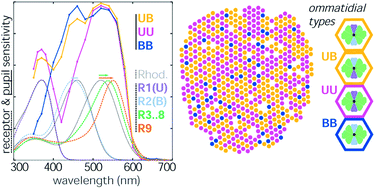The red admiral butterfly’s living light sensors and signals†
Abstract
We studied the wing colouration and the compound eyes of red admiral butterflies with optical methods. We measured reflectance spectra of the wing and scales of Vanessa atalanta and modelled the thin film reflectance of the wing membrane and blue scales. We utilized the eyeshine in the compound eye of Vanessa indica to determine the spectral and polarisation characteristics of its optical sensor units, the ommatidia. Pupil responses were measured with a large-aperture optophysiological setup as reduction in the eyeshine reflection caused by monochromatic stimuli. Processing of spectral and polarisation responses of individual ommatidia revealed a random array with three types of ommatidia: about 10% contain two blue-sensitive photoreceptors, 45% have two UV-sensitive photoreceptors, and 45% have a mixed UV–blue pair. All types contain six green receptors and a basal photoreceptor. Optical modelling of the rhabdom suggests that the basal photoreceptors have a red-shifted sensitivity, which might enhance the red admiral’s ability to discriminate red colours on the wing. Under daylight conditions, the red shift of the basal photoreceptor is ∼30 nm, compared to the rhodopsin spectrum template peaking at 520 nm, while the shift of green photoreceptors is ∼15 nm.

- This article is part of the themed collection: Biological and bio-inspired optics


 Please wait while we load your content...
Please wait while we load your content...
